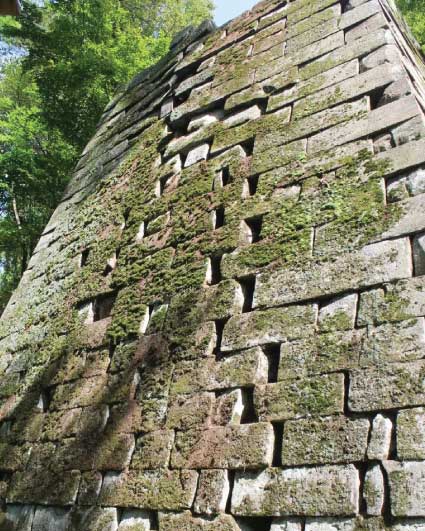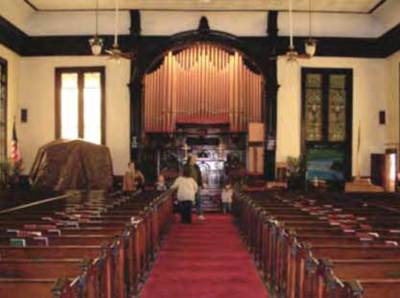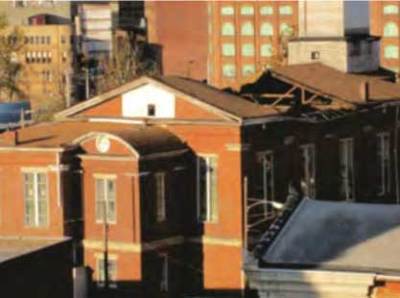|
By Lynn May is National Historic Preservation Month! Begin a building project this May and celebrate historic preservation. Not sure where to start? Watch this video about How to Assess a Historic Building and then use this helpful checklist to prioritize your building’s needs. Have more questions? Contact [email protected] for help. The West Virginia Humanities Council observes National Preservation Month this May by bringing Sir Neil Cossons, distinguished historian, museum director and former chairman of English Heritage, to West Virginia for a speaking tour. English Heritage is the advisor to the government of the United Kingdom on the historic environment of England, from Stonehenge to manor houses.
On May 7, Cossons begins his tour with the 7:00 p.m. presentation of “A Future for the Past: Preserving the Past as an Asset for the Future” at the Jefferson County Courthouse in Charles Town. He will repeat the program on May 8 at 7:00 p.m. at West Virginia University’s Erikson Alumni Center in Morgantown and May 9 at 7:00 p.m. at West Virginia Independence Hall in Wheeling. The programs are free and the public is cordially invited to attend. Cossons will discuss the philosophy and processes for historic preservation in England. He will examine what is preserved, why and how, consider new uses for historic buildings, and share examples of how communities have used historic places as the framework for creating the future in England and other countries. Sir Neil was knighted in 1994 for his work with museums and historic preservation and has advised governments, museums, and preservation organizations in several countries. His visit to West Virginia was facilitated by his friend and colleague Dr. Emory Kemp, professor emeritus at West Virginia University. In addition to being former chairman of English Heritage, Cossons was the first director of the Ironbridge Gorge Museum – a World Heritage site in Shropshire encompassing 10 museums collectively telling the story of the Industrial Revolution, director of the National Maritime Museum in Greenwich, and has worked on a number of World Heritage nominations. Officially known as the Historic Buildings and Monuments Commission for England, English Heritage cares for the National Heritage Collection of historic sites and monuments while serving as guardian of over 500,000 objects and 12 million photographs in their public archives. They protect an amazing range of properties, sites, and objects that include castles, shipwrecks, battlefields, and gardens such as the aforementioned Stonehenge, Hadrian’s Wall, Charles Darwin’s diaries and the Duke of Wellington’s boots. Support for “A Future for the Past: Preserving the Past as an Asset for the Future” is provided by West Virginia University, Elizabeth Stifel Kline Foundation, Mr. and Mrs. Ogden Nutting, Jefferson Distributing, John Allen, Jr., West Virginia Division of Culture and History, and the Bavarian Inn. The Humanities Council also thanks Dr. Emory Kemp, the Honorable David H. Sanders, Arts and Humanities Alliance of Jefferson County, Harpers Ferry Historical Association, Preservation Alliance of West Virginia, Shepherd University Historic Preservation Program, and the Wheeling National Heritage Area Corporation. For more information contact the West Virginia Humanities Council at 304-346-8500. Four members of the Coopers Rock Foundation Board of Directors who are also rock climbers cleaned off the Henry Clay Iron Furnace, of Coopers Rock State Forest, on Friday September 21st, 2012. “Plants were growing all over that structure,” said Jan Kiger, one of the participating climbers. “And we’re not talking just ferns and weeds. There were lots of small trees that had taken root in the soil between the stone blocks.” Unchecked tree growth could eventually threaten the stability of the structure. Most of those were birch tree saplings, pointed out Adam Polinski, another CRF climber who helped out that day. “They are the same kind of trees frequently seen growing on or around the rocks we climb on here at Coopers Rock.” While the ferns and weeds were relatively easy pickings, the trees were harder to eradicate. “After we cut the trees off, we dug out as many stumps and roots as we could, to prevent stump-sprouting and tree growth in the same places all over again.” The woody plants are the greatest threat to the long-term preservation of the furnace structure, explained Polinski. “The root systems expand as the trees grow, and that can slowly push apart the blocks.” Carol Tannous added that if something wasn’t done, tree growth on the furnace would lead to its disintegration. “You can see where some of the blocks have loosened over the decades. This is a famous local landmark, and we don’t want to see it fall apart.” The climbers set up rope systems using trees nearby the furnace for anchors. “We purposely did not use the furnace structure itself for safety anchoring in any way”, explained David Riggs, the other climber who helped with the project. “We took a ‘tread lightly’ approach. This is one of the very oldest surviving structures in the greater Morgantown area, constructed in the 1830’s. We even took pains to not disturb the moss on the sides of the furnace. It looks good and doesn’t do any harm, so we intentionally left it in place.”
This was not the first time that the Foundation, and rock climbers, helped out the Henry Clay Iron Furnace in this way. 12 years ago, on July 22nd, 2000, two CRF Board members who are also rock climbers, Lisa Rayburn and Adam Polinski, were joined by 5 other local climbers in a furnace-cleaning effort: Rob Riffe, Scott Ridenour, Shawn Stafford, Bryn Perrott, and Richie Moyers. They accomplished the same task as this go-around. One of the differences between that time and this was that, in 2000, an approved herbicide was sprayed on any remaining root structures to prevent re-growth. This time, no herbicides were used, and instead, more effort went into physically removing stumps and roots. The other main difference was due to the gear and expertise of David Riggs. David is an expert caver as well as a rock climber, and he provided mechanical ascenders for the group. “The ascenders allowed us to climb up the ropes. Between those and rappelling devices, which enable one to descend a rope, each of us was easily able to go up or down a rope and single-handedly cover an entire face of the furnace.” “It’s a real privilege to care for such an old and important part of our local history – especially in this hands-on way”, said Carol Tannous. The furnace is about 175 years old. “This work will help keep that structure standing for years to come.” The prominent Second Presbyterian Church in Wheeling’s Center Market Square District has an interesting past and a promising future. Constructed in 1850, the church reflects a checkered past for antebellum Virginia and the complexity of Wheeling’s population. The church founders included secessionists from both the First Presbyterian Church and the United States. One of the church’s founders, Mr. John Goshorn, was a slave-owner. As the church congregation grew, a tide favoring Abolitionism was evident. The church sexton, Mr. John Gaunt, was a free black man, and the Second Presbyterian Church was the site of the Freedmen’s Association meeting in 1865.
The Near Earth Object Foundation is the current owner of the church, and this organization sees the value in preserving and celebrating the history of Wheeling and the church. It is involved in an adaptive re-use project for the church to create an urban observatory, educational facility, and performing arts center in Wheeling’s popular Market Square. The Near Earth Object Foundation (NEO) has many long-term goals for the church, but currently, it is engaged in a most-needed restoration effort to fix the collapsed roof and the original 50-foot truss structure. Not only is the NEO interested in science, astronomy, and history, but it’s also into the preservation trades. The group will provide an educational opportunity regarding large timber construction as all of the timbers being used for the truss system will be created in a large beam sawmill at the Garvin’s Dairy buildings located outside of Wheeling. These buildings boast ample room to cut the large truss pieces and do hand hewing of components. The wood for the trusses will be cut from local timber found on the Garvin’s Dairy land. Much of timber will come from trees downed by last summer’s “Derecho storm.” The group will utilize the “windfall” to cut as much of the construction material as possible and has been busy measuring, peeling, and hewing, in addition to getting the large beam sawmill set up. Ultimately the “historic vision” is to restore the church to its antebellum and Civil War era configuration. It will be used as a digital broadcast/webcast studio, flexible performance and presentation space, and “urban observatory”. The building and site are included in NASA West Virginia Space Grant project “SolarMax2012”, solar astronomy. The Near Earth Object Foundation has Sir Arthur C. Clarke’s blessing to establish the “Arthur C. Clarke Near Earth Object Observatory” here in West Virginia. For more information on the 2013 WV Endangered Properties, visit http://pawv.org/endangedlist2013.htm West Virginia has had its Residential Rehabilitation Tax Credit for over 10 years. With this tax credit, historic homeowners benefit from a 20% credit on qualified expenditures, which include roof replacement, electrical wiring repairs and updates, window rehabilitation, architectural and engineering fees, and much, much more. For the homes to be considered “historic”, they must be listed individually in the National Register of Historic Places or they can be listed in a National Register historic district, a collection of historic buildings in a concentrated area.
In the last 11 years, 67 historic properties have been rehabilitated using this tax credit program. In West Virginia, there are over 1,000 historic resources, and this number does not individually count each property listed in the historic districts. So, why the discrepancy in number of owners utilizing the tax credit and number of historic resources? Property owners continue to fix-up their homes, and many middle-class families live in historic districts. All of these people could benefit from this tax credit. We at Preservation Alliance believe that two reasons the tax credit is not being utilized more effectively are because homeowners are turned off by anything to do with taxes and that the paperwork is intimidating. To counter these claims, we have created a twelve-page guidebook that explains the tax credit and walks homeowners step-by-step through the tax credit application process. Additionally, this downloadable guide explains who to contact to apply for this tax credit. So before you start any summer renovations, take a look at the guidebook. You might qualify for this 20% tax credit! If you aren’t certain whether your property is listed in the National Register of Historic Places, contact us at [email protected]. We will help you to figure out whether your property qualifies as “historic.” You can find the downloadable guidebook in PDF format at http://pawv.org/funding.htm.
(For more information about the history of all these springs, check out this excellent online exhibition about medicinal springs from the University of Virginia’s Claude Moore Health Sciences Library.)
It was popular belief that the sulphur waters, taken both internally as well as bathed in were a curative for any number of diseases, and ostensibly that is why people, (mostly the rich) visited the resorts. There was however another reason of equal import; to escape the oppressive heat, humidity, insects, and various diseases prevalent along the summer coast of the Virginias. John J. Moorman, The Virginia Springs of the South and West, Philadelphia: J. B. Lippincott, 1859: facing page 217. Historical Collections & Services, Claude Moore Health Sciences Library, University of Virginia. http://www.hsl.virginia.edu/historical/exhibits/springs/blue.cfm Blue Sulphur, so named for the iridescent color of the springs was constructed in 1834, the year the resort opened. It began its decline in the 1850s due to competition. In 1859, it became a college for Baptist ministers but closed in 1861 with the outbreak of the Civil War. Both Confederate and Union troops utilized the site as a hospital and camp until it was burned by departing Union troops in 1864 leaving only the pavilion and spring un-touched. The saving of the site is in the planning stages for the Save the Blue group and the Greenbrier Historical Society. Plugged up drains have caused a swampy condition which will be dealt with first. Then work can begin saving the pavilion which is in need of much attention. Once work is complete, the site will become a two acre park, and a most enjoyable park it will be. I just wonder if anyone will “take the waters?” For more information on the 2013 WV Endangered Properties, visit http://www.pawv.org/endangedlist2013.htm. |
News and NotesCategories
All
Archives
May 2024
Subscribe to our mailing list to receive e-news updates on historic preservation news and events in West Virginia.
|
Get Involved |
Programs |
Contact UsPreservation Alliance of West Virginia
421 Davis Avenue, #4 | Elkins, WV 26241 Email: [email protected] Phone: 304-345-6005 |
Organizational Partners:
© COPYRIGHT 2022 - PRESERVATION ALLIANCE OF WEST VIRGINIA. ALL RIGHTS RESERVED.










 RSS Feed
RSS Feed



